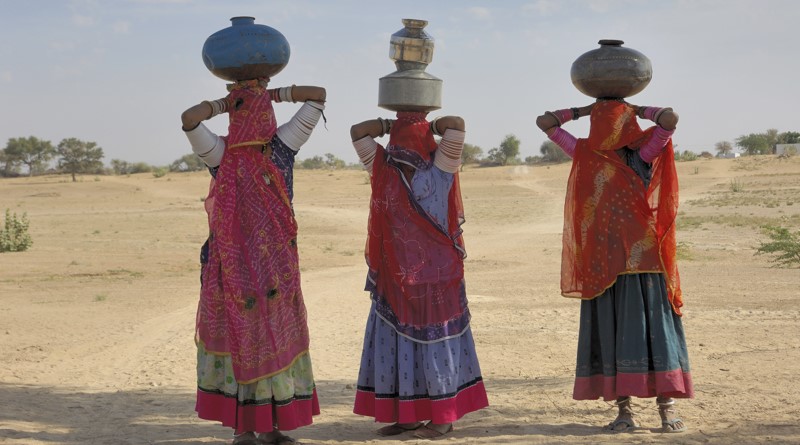Climate change to bring enhanced droughts worldwide; India to be among worst hit

India is among several countries where more frequent and longer-lasting droughts caused by rising global temperatures pose significant risks to people and ecosystems, a new research study has warned, stating that even a modest temperature increase of 1.5°C will spell serious consequences in coming decades.
The research from the University of East Anglia (UEA) in the UK chose six countries – India, China, Ethiopia, Ghana, Brazil and Egypt – for study as they provided a range of contrasting sizes and different levels of development on three continents spanning tropical and temperate biomes, and contain forest, grassland and desert habitats.
The study, led by Dr Jeff Price and his colleagues in the Tyndall Centre for Climate Change Research at UEA, estimated the impacts that different degrees of global warming — between 1.5°C and 4.0°C — would have on the probability and length of severe drought. The study quantified the projected impacts of alternative levels of global warming upon the six countries.
“Current pledges for climate change mitigation, which are projected to still result in global warming levels of 3 °C or more, would impact all the countries in this study,” said Jeff Price, a UEA associate professor of biodiversity and climate change.
“For example, with 3°C warming, more than 50 per cent of the agricultural area in each country is projected to be exposed to severe droughts lasting longer than one year in a 30-year period.”
“Using standard population projections, it is estimated that 80 per cent to 100 per cent of the population in Brazil, China, Egypt, Ethiopia and Ghana (and nearly 50 per cent of the population of India) are projected to be exposed to a severe drought lasting one year or longer in a 30-year period,” said Price.
“In contrast, we find that meeting the long-term temperature goal of the Paris Agreement, that is limiting warming to 1.5°C above pre-industrial levels, is projected to greatly benefit all of the countries in this study, greatly reducing exposure to severe drought for large percentages of the population and in all major land cover classes, with Egypt potentially benefiting the most.”
The general estimates for the study’s scenarios are:
- With 1.5°C warming, drought probability is projected to triple in Brazil and China, nearly double in Ethiopia and Ghana, increase slightly in India, and substantially increase in Egypt.
- With 2°C warming, the probability of drought is projected to quadruple in Brazil and China; double in Ethiopia and Ghana; reach greater than 90 per cent probability in Egypt; and nearly double in India.
- With 3°C warming, the probability of drought projected to be in Brazil and China is 30-40 per cent; 20-23 per cent in Ethiopia and Ghana; 14 per cent in India but nearly 100 per cent in Egypt.
- With 4°C warming, the probability of drought projected in Brazil and China is nearly 50 per cent; 27-30 per cent in Ethiopia and Ghana; nearly 20 per cent in India; and 100 per cent in Egypt.
- In most countries, the projected increase in drought probability increases almost linearly with increasing temperature. The exception is Egypt, where even slight amounts of global warming could lead to large increases in drought probability.
Prof Rachel Warren, leader of the overall study of which this paper is one output, said: “Not only does the area exposed to drought increase with global warming, but it also increases the length of the droughts.
“In Brazil, China, Ethiopia, and Ghana droughts of longer than two years are projected to occur even in a 1.5°C warming scenario.”
In a 2°C warming scenario, the length of droughts projected in all countries (except India) are projected to exceed three years. In a 3°C warming scenario, droughts are projected to approach 4–5 years in length and in a 4°C warming scenario, severe droughts of longer than five years are projected for Brazil and China, with severe drought the new baseline condition.
Also, the percentage of land projected to be exposed to a severe drought of longer than 12 months in a 30-year period is expected to increase rapidly by the 1.5°C warming scenario in Brazil, China and Egypt, and in areas of permanent snow and ice in India.
India and China both have large areas currently under ‘permanent’ ice and snow cover. However, in the 3°C warming scenario, 90 per cent of these areas are projected to face severe droughts lasting longer than a year in a 30-year period, the study stated.
These areas form the headwaters of many major river systems, and thus the water supply for millions of people downstream. Increasing probability and duration of severe drought points to potential declines in water storage in the Chinese Himalayas in the form of snow and ice.
Drought can have major impacts on biodiversity, agricultural yields and economies. This study indicates that all six of the countries will need to deal with water stress in the agricultural sector, potentially through shifting crop varieties or through irrigation, if water is available. The amount of adaptation required to cope with this increase in drought therefore increases rapidly with global warming.



